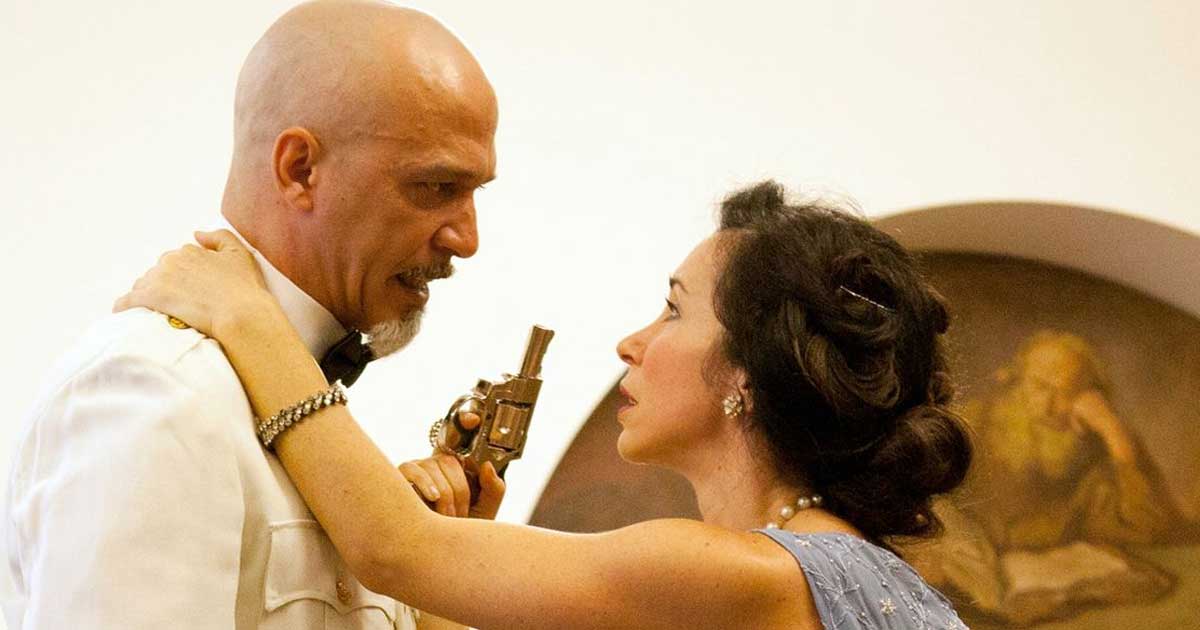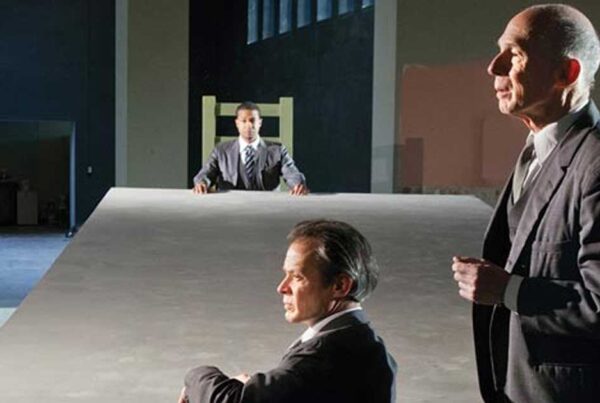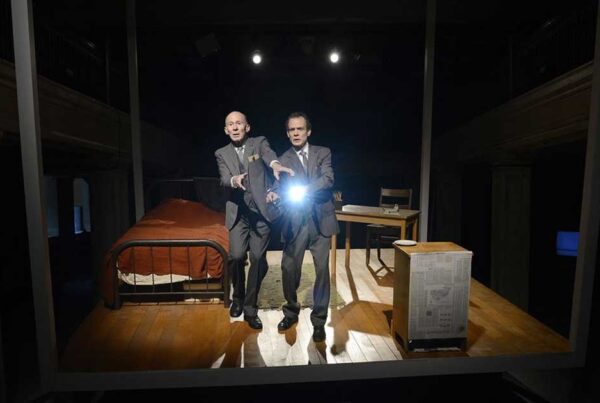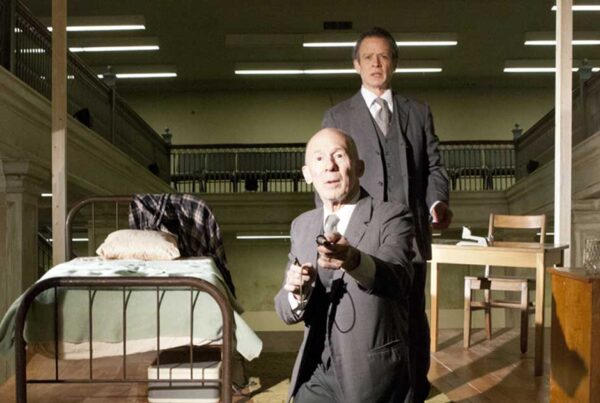
Pittsburgh Post-Gazette – Was it d’Annunzio in the conservatory with the pistol? Emilia in the kitchen with the cleaver? Finzi in the bedroom with the pillowcase? . . . or one of many other permutations of 10 characters, infinite tools of mischief and more than a dozen rooms, not to mention hallways and patios.
Such are the character riches and geographical sprawl of “Tamara,” the ambitious, site-rich theater event (dinner included!) with which Quantum Theatre is enlivening the handsome, labyrinthine Temple Rodef Shalom in Oakland.
But – not to dilute the fun of the Sherlocks and Marples among us – the whatsit and whodunit angles of the script by John Krizanc, co-conceived by Richard Rose, don’t matter that much: it’s the experience that entertains.
My favorite part is the setting, the monumental building richly adapted and decorated as an Italian mansion of 1927 by Stephanie Mayer-Staley, spiced and colored by Pei-Chi Su’s wonderful period costumes. Close behind comes the cast, investing the characters with invention through all the vicissitudes of something like real life, soap opera division.
And then there’s the audience, hustling to keep up. The play’s true drama is in our individual hunt and discovery.
So the story is just a giant MacGuffin. Sure, behind it is some real history, the plotting and counter-plotting of scheming artists, politicos and spies in Mussolini’s Italy, presided over by the megalomaniacal national poet, Gabriele d’Annunzio (Fermin Suarez). He was a legitimate hero of past struggles for independence, but now he’s his own monument, infatuated with national, aesthetic and erotic passions.
Gathered at his villa (a gift from Il Duce) are his mistresses, both fading (Robin Abramson) and prospective (Megan MacKenzie Lawrence as the French-speaking Tamara), and . . . well, who is composer de Spiga (Ken Bolden)? I mean really? Easier to place are the pretty maid (Rachel McKeon), unctuous butler (Ethan Hova), frustrated housekeeper (Tammy Tsai) and passionate chauffeur (Thomas Constantine Moore). Add a teenage would-be ballerina (Cathryn Dylan) and a fascist Jew in military uniform (Robert Turano), and the game’s afoot.
It’s challenging enough to detect who’s sleeping with whom, let alone who’s plotting how and who really isn’t what they seem.
The evening starts with champagne on the patio (inside if it rains), where we meet the characters. Then we’re sent to different rooms, but when that first scene ends and the characters head off in different directions, you have to choose whom to follow. And then choose again. And again.
The obsessives may pursue the same character throughout; others may change horses after every scene. As a result, we all see a different play. At intermission everyone gathers for dinner, and the best plan is to get those at your table to share what they’ve learned.
Then back to the chase. Move fast! Eventually, everyone ends up in the large oratorio, but even then the characters and their audience posses arrive at different times, so we all get (or don’t get) different parts of the story. It’s something like jumping backwards and forwards in a large novel.
Or like life.
Blessedly, there are attendants to make sure we don’t go where we shouldn’t, and there’s one pathway recommended to those of limited movement. We’re advised how to move without impeding the actors, and you mustn’t, of course, imagine you’re part of it all: we’re silent observers.
That’s a great fantasy and a lot of fun, full of aphoristic flourish and melodrama. I saw it some 30 years ago in Los Angeles and later off-Broadway, and Quantum’s expansive, detailed version measures up. It even approaches high artistry when you consider what director John Shepard and his cast accomplish, with scenes going on simultaneously in several rooms, needing to dovetail as the characters move.
To make maximum sense of all this on a single visit, the Post-Gazette sent a swat team of four critics, made up of me, Sharon Eberson, Maria Sciullo and Marylynne Pitz. I followed mainly the older mistress, Sharon tracked the sinister Finzi, Maria pursued d’Annunzio and Marylynne, the not-so-entirely naive young ballerina.
Maria found d’Annunzio “by turns arrogant and petty, frustrated (by his inability to woo Tamara, to write the kind of poetry that once made him a powerful influence on Italian society, to keep his women happy) and sexually insatiable.
“But he’s also rather unremarkable, seeming to be just another powerful brute. Racing about to catch snatches of more interesting conversations in other locales, I yearned to know more about the big picture. After so many months of being a kept man by Mussolini, d’Annunzio seemingly became a metaphor for his beloved country: change was happening but he felt helpless to take an active hand in it.
“The second act is where d’Annunzio seems ready to accept that he can change, and here Mr. Suarez really shines.”
Sharon attached herself to Finzi “and became a loyal follower, compelled by the complexity and menace brought to the part by Robert Turano. Like his real-life counterpart, Finzi grew up poor and was a victim of anti-Semitism before joining the military and becoming a zealot for Fascism. We encounter him barking orders while sniffing out information or demanding it by brutalizing everyone in his path.
“I was so invested in how things would turn out for ‘my guy,’ I determined to stay on Finzi’s team, even if I had to run to keep up. Toward the denouement, he ostensibly left the grounds and we were stopped from following him outdoors. So the Finzi group scampered after one of the nearby characters. When we all met up at the end, I got a glimpse of my guy’s fate, but without the satisfaction of knowing all that had led him to it.”
As to Marylynne, she thought Cathryn Dylan as the convent-educated young ballerina gave “a pitch perfect performance infused with girlish aspiration and confidence. She makes us believe that she has never felt the stirrings of lust and is truly unsettled by that experience.
“Still, she maintains that her priorities are ‘the Lord Jesus, papa and dancing.’ She is impatient to dance for d’Annunzio so he will recommend her to his friend, Diaghilev, the famed impresario, and she is ready to compete with other women for male attention.
“But despite her emphatic pronouncements about the value of Christianity and prayer, she loathes outsiders and bristles when Tamara, a Polish artist, sketches her. It’s an especially ugly moment for such a beautiful young girl.
“‘Don’t you hate foreigners?’” she asks. D’Annunzio’s former lover answers, “how does the modern woman reconcile art with intolerance?”
As all this suggests, each of the play’s characters is richly imagined and detailed – after all, each is almost continuously on stage, in one room or another. “Tamara” is a towering layer cake of scenes, and you can only eat a bit on any one visit.
This creates some frustration. Maria complained, “since there were many ‘missing’ scenes involving other characters, I felt the excellent scene in the library between d’Annunzio and Mario the chauffeur wasn’t as emotionally resonant as it might have been since I had no idea who Mario was (until revealed in dialogue).”
Sharon is determined to return: “My plan had been to follow another character, but now I might have to stalk Finzi after the dinner break. The point being, I can’t wait to go back and relive the experience in a new way.”
Ditto Maria: “My general response is ‘when can I go again?’ I was fascinated with the timing involved and the actors’ nimble ability to work around dumb audience members who wandered into rooms at bad moments or who, in one case, wound up smack in the middle of d’Annunzio’s bedroom, the equivalent of center stage.”
On my part, in following the older mistress I partook of grand histrionics made vivid by Ms. Abramson, especially a scene in her bedroom when she . . . . But no, I’m not going to tell you that. Not unless you’ve seen “Tamara” and you’re willing to meet me for coffee and compare experiences…




